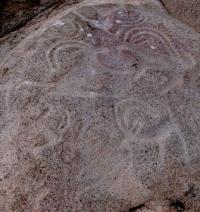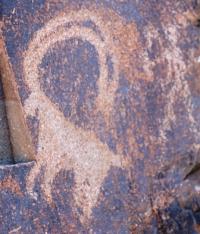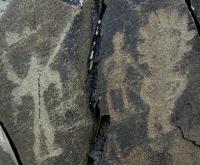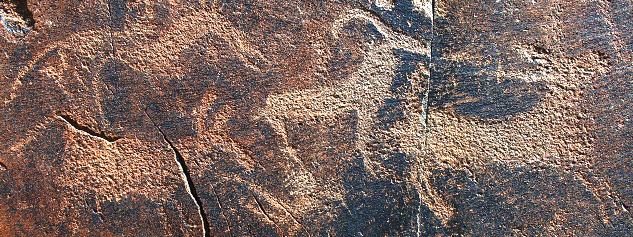Вы здесь
Researcher of petroglyphs Marikovsky.




Tours on cave paintings of Kazakhstan.
“The day glowed hotter with sparkling greetings,
The cold circle of the earth is hot with breath, -
And the cloud lit up, pierced by light
An invincible ray! ”
Konstantin Balmont. "Mists."
Petroglyphs of Semirechye.
Marikovsky is known as a wonderful scientist, naturalist, author of twenty-seven books, who devoted his life to the study of insects, as well as writing scientific and popular science articles about ants, ticks, poisonous spiders that live on the territory of our republic.
Traveling in Kazakhstan, Pavel Justinovich simultaneously studied cave paintings, which are of great interest, both for zoological and historical science. He became the first zoologist to introduce these cave paintings into scientific circulation and give them a scientific description.
Traveling along the Seven Rivers and the north-eastern coast of Balkhash, Marikovsky discovered a large number of rock writings and, having processed them, published a series of articles on the fauna of game animals, hunting methods and objects from the distant past.
Most of the drawings belong to the era of the early and late nomads (X - VIII centuries BC - III AD). The extinction of the art of rock writings occurred in the Middle Ages. The artistic value of the drawings is just as different, as noted in articles by Pavel Justinovich. Many of the drawings are made artlessly.
Along with this, most of them are distinguished by amazing realism, precision of proportions, flexibility and beauty of form, grace of movements. Some of the drawings are so highly artistic that they leave no doubt in the performance of their talented artists.
The systematization of cave paintings allowed the scientist to determine the fauna of the mountainous and foothill regions of Kazakhstan in ancient times. Among the drawings, the images of a bipedal goat prevail, more rarely, a mountain ram, called “goatlice,” which was the main motive for the work of ancient hunters and shepherds.
This indicates the wide distribution of these animal species in Kazakhstan. The cave paintings are executed in a different style: one line or a solid beating. Numerous figures of small goats are carved on the rocks next to other large images and accompany them everywhere, often layering on them.
Many images are conditional, stylized. Traditionally, the figures depict animals with large horns, emphasizing their power and strength. Often the size of the horns is greatly exaggerated. The vast majority of animals are depicted individually.
But there are drawings depicting some features of life and behavior of mountain goats. Such are the animals running one after another, standing on their hind legs - a pose characteristic of playing kids or fighting adult males, faced with a dog or a wolf, chased by a person. In addition, in the gallery of rock art, ancient artists often depicted a dog, a maral, a wolf, a camel-bactrian, a camel-dromedary.
Less commonly, a horse, a gazelle, a kulan, a round, a wild boar, a deer, a lynx, a tiger, a bear, a leopard, a cheetah, a fox and its closest relative, the corsac. Moreover, dogs are subdivided by Marikovsky into three breeds:
1) individuals with a massive neck, a large head and thick hair;
2) individuals specialized for the enclosure of wild animals and mountain hunting;
3) individuals that are practically no different from their ancestor - the wolf.
The scientist determines the approximate chronological framework for the taming of a dog by a man and his further selection and specialization in hunting and guard breeds. The author draws the reader's attention to the process of taming a horse and its role in the economy of the ancient population of Kazakhstan.
Among the cave paintings, wild horses are traced, similar to the Przhevalsky horse, as well as domesticated, used for economic and military purposes, for round-robin and individual hunting. Among the cave paintings, the scientist revealed that not only dogs and horses, but also tame cheetahs and leopards were used in the hunt.
At the same time, he notes that only the patrimonial nobility could own the latter. According to Marikovsky, ancient artists depicted not only the local fauna, but also exotic animals from neighboring countries, for example, Indian elephants, which indicates close ties with other peoples.
There are drawings of fantastic animals: griffins, two-headed animals, three-humped camels. Based on cave paintings, the scientist reconstructed hunting methods. First of all, he identifies a round-robin method, which speaks of an abundance of animals, on the one hand, and a round-up, as a tactic of military training of local tribes, on the other. Individual hunting was the second way.
There are also such methods as hunting, using the maternal instinct of the female (the attached cub serves as a bait for the female and herd). When describing the weapons of an ancient hunter, the author distinguishes the bow and arrow as the predominant one.
At the same time, explaining the drawings of hunters with crossbows, the scientist suggests that the crossbows were borrowed from Europe. However, the last point is controversial. It is known that at the beginning of the Ist century AD near the city of Almaty, the sun Parthian and Chinese troops met.
On the side of the Parthians were the captive Roman legionaries of Emperor Trajan. Chinese archers, armed with crossbows, without making contact, simply shot down the legionnaires. This means that the local population could receive crossbows as a result of trade exchanges from China.
Some of the author’s assumptions about the drying up of the steppe and the change in its fauna were further confirmed in the works of L.N. Gumilyov.

Authority:
The magazine "Wind of Wanderings" No. 3, 2007.http://veters.kz/
Photos by
Alexander Petrov.







